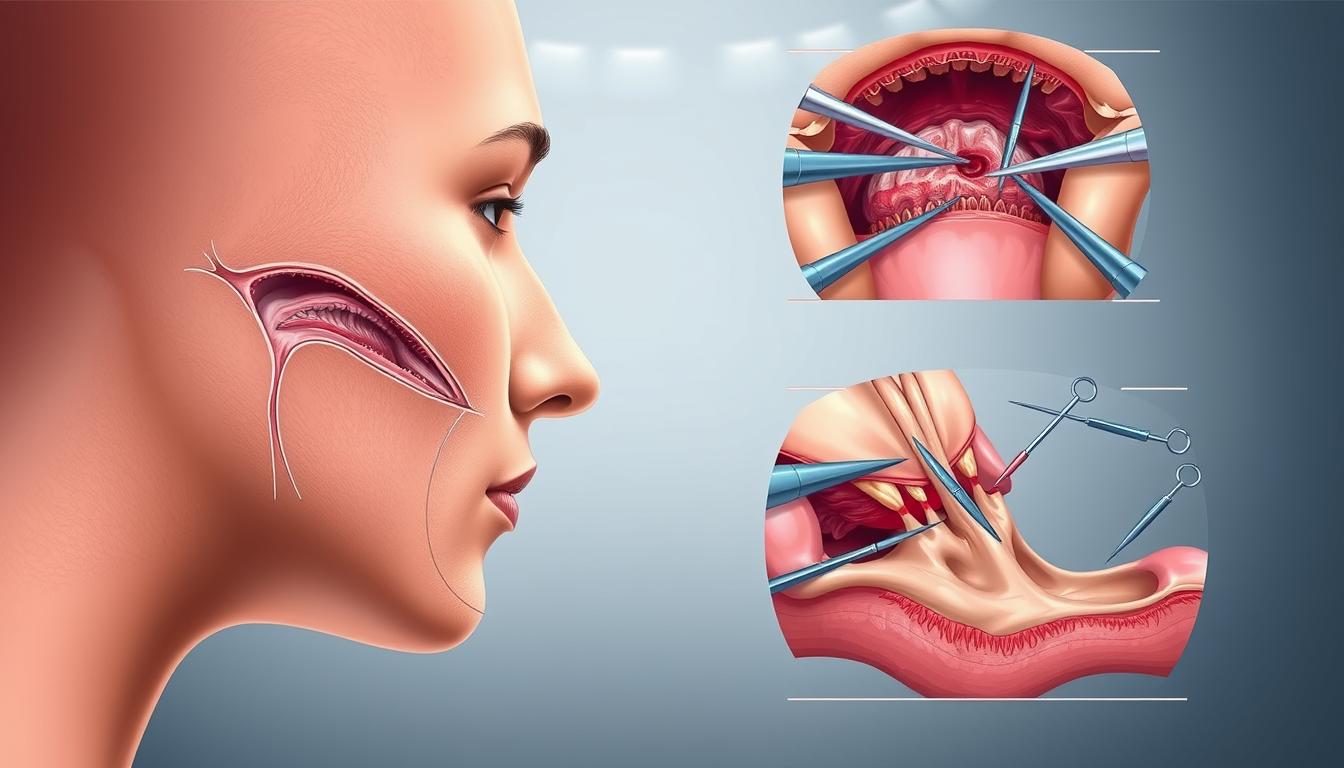Chin reduction surgery is a specialized procedure designed to decrease the length, width, or overall size of the chin, creating better facial harmony. This surgical intervention helps patients achieve a more balanced appearance by ensuring the chin is proportionate to other facial features.
The procedure addresses concerns of an overly prominent chin that may create facial imbalance or cause functional issues. By modifying the bone structure or removing excess tissue, surgery can help patients achieve their desired results.
Key Takeaways
- Chin reduction surgery creates facial harmony by decreasing the chin’s size.
- The procedure helps achieve a balanced appearance.
- It addresses concerns of an overly prominent chin.
- Surgery modifies bone structure or removes excess tissue.
- Patients achieve their desired results through this surgical intervention.
Understanding Chin Reduction Surgery
Chin reduction surgery is a transformative procedure that can significantly enhance the overall aesthetic of one’s facial profile. This surgery is designed to decrease the length, width, or overall size of the chin, creating a more balanced look with other facial features.
What Is Chin Reduction Surgery?
Chin reduction surgery, also known as reduction genioplasty, is a specialized plastic surgery procedure. It involves surgically altering the chin bone or surrounding tissue to decrease its projection, width, or overall size. The goal is to achieve a more harmonious facial profile.
Candidates for Chin Reduction
Ideal candidates for chin reduction surgery include individuals with disproportionately large chins, those with chin asymmetry, or patients experiencing functional issues related to chin size. Candidates should be in good physical health and have realistic expectations about the outcome.
Aesthetic and Functional Benefits
The surgery offers both aesthetic and functional benefits. Aesthetically, it improves facial balance and enhances the profile. Functionally, it can improve jaw function and bite alignment. By reshaping the chin, patients can achieve a more harmonious relationship between their chin, nose, and other facial features.
Types of Surgery Chin Reduction Procedures
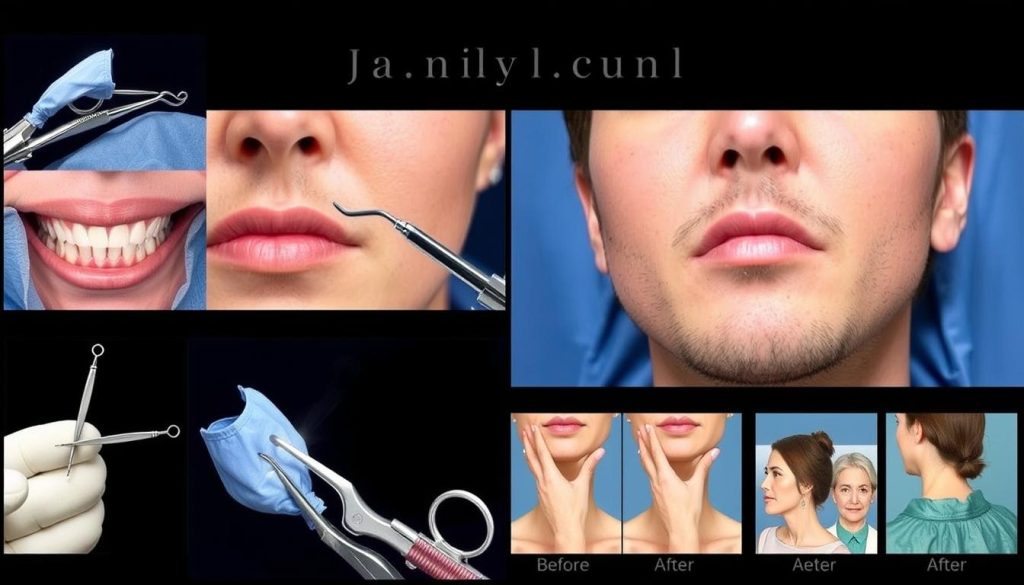
There are multiple surgical approaches to chin reduction, each with its unique benefits. The choice of procedure depends on the individual’s facial structure, the degree of reduction needed, and whether other facial features require adjustment.
Sliding Genioplasty (Osseous Genioplasty)
Sliding genioplasty is a comprehensive chin reduction procedure that involves repositioning the chin bone to achieve the desired projection and shape. This bone-based approach allows for precise three-dimensional control, making it ideal for significant reductions or complex chin reshaping needs.
During the procedure, an incision is made inside the mouth, and the chin bone is cut, repositioned, and secured with titanium plates and screws, leaving no visible external scars.
Chin Implant Procedures (Mentoplasty)
Mentoplasty, or chin implant surgery, involves placing a chin implant directly on the bone via a short incision under the chin or inside the mouth. This procedure can be used for both chin augmentation and reduction, depending on the type of implant used.
Comparing Surgical Approaches
When comparing surgical approaches, sliding genioplasty offers more dramatic and customizable results but involves a more extensive surgery and recovery period. Implant procedures are generally less invasive with shorter recovery times but may not address severe chin prominence as effectively.
The Surgical Process Explained
Understanding the surgical process is essential for patients considering chin reduction surgery. This knowledge helps in setting realistic expectations and preparing for the procedure.
Pre-Surgical Consultation and Planning
The pre-surgical consultation is a critical component where the plastic surgeon evaluates the patient’s facial structure, chin proportion, and discusses aesthetic goals and expectations. During this phase, the surgeon may use 3D imaging technology to visualize potential outcomes and help patients understand what results can realistically be achieved through chin reduction surgery.
The surgeon will review the patient’s medical history, current medications, and overall health status to ensure they are a suitable candidate for the surgical procedure. This comprehensive evaluation is crucial for determining the best approach for the patient’s individual needs.
Anesthesia Options
Anesthesia will be administered for the patient’s comfort during the surgical procedure. The choices include intravenous sedation and general anesthesia. The surgeon will recommend the best choice based on the complexity of the surgery and patient preference.
Incision Techniques and Locations
Incision techniques vary depending on the specific procedure. The two primary options are an external incision hidden in the natural crease under the chin or an internal incision inside the mouth along the lower lip. The choice between these techniques depends on the complexity of the reduction and the patient’s preferences regarding scarring.
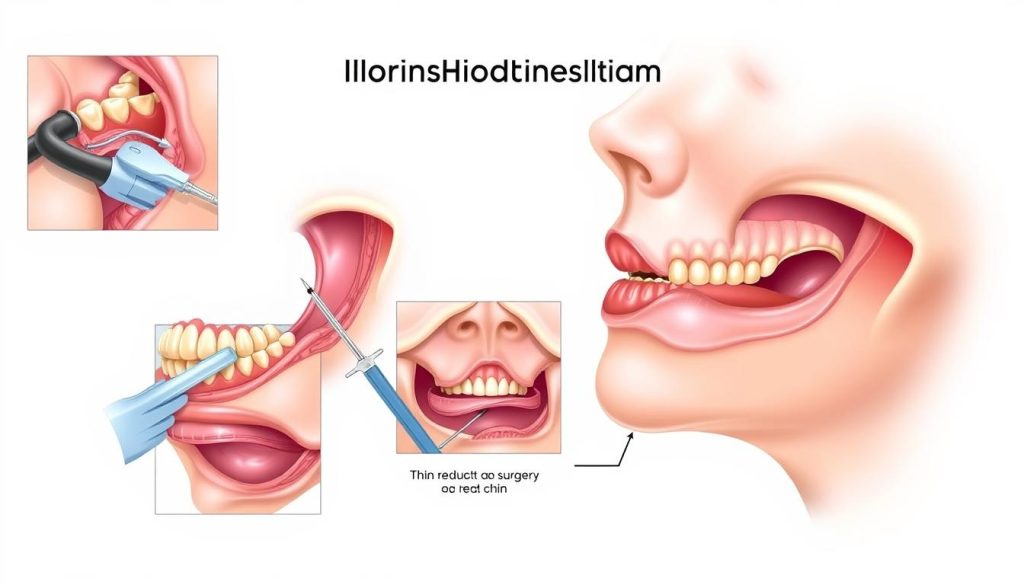
Duration and Hospital Stay
The duration of chin reduction surgery typically ranges from 1-2 hours, depending on the complexity of the case and whether it’s combined with other facial procedures. Most chin surgeries are performed as outpatient procedures, allowing patients to return home the same day. However, more extensive surgeries may require an overnight hospital stay for monitoring.
| Procedure Aspect | Description | Considerations |
|---|---|---|
| Pre-Surgical Consultation | Comprehensive evaluation and planning | 3D imaging, medical history review |
| Anesthesia Options | Intravenous sedation or general anesthesia | Surgeon’s recommendation based on procedure complexity |
| Incision Techniques | External or internal incisions | Considerations for scarring and surgical access |
| Duration and Hospital Stay | 1-2 hours, outpatient or overnight stay | Complexity of the case and combined procedures |
Before the surgery, patients receive specific instructions regarding eating, drinking, medication adjustments, and other preparations to ensure optimal surgical outcomes. By understanding these aspects, patients can better prepare themselves for the surgery and the recovery process.
Recovery After Chin Reduction Surgery
After undergoing chin reduction surgery, patients typically enter a recovery phase that requires careful attention to post-operative care instructions. Proper care during this period is crucial for minimizing complications and achieving the desired outcome.
Immediate Post-Operative Care
Immediate post-operative care involves applying a compression bandage around the chin to minimize swelling and support the newly contoured tissue. Patients are also advised on how to keep the incision site clean to prevent infection.
Managing Swelling and Discomfort
Significant swelling and bruising are expected in the first 48-72 hours. Ice packs and prescribed medications help manage discomfort and reduce inflammation.
- The initial recovery period generally lasts 1-2 weeks.
- Complete resolution of swelling may take 3-6 months.
- A soft or liquid diet is recommended for the first week.
| Recovery Aspect | Details |
|---|---|
| Immediate Care | Compression bandage, keep incision site clean |
| Managing Swelling | Ice packs, prescribed medications |
| Dietary Restrictions | Soft or liquid diet for the first week |
Potential Risks and Complications
While chin reduction surgery is generally considered safe, it’s crucial to understand the potential risks and complications associated with the procedure. As with any surgery, there are risks involved that can impact the outcome and recovery.
Common Side Effects
Common side effects following chin reduction surgery include temporary numbness in the lower lip and chin area, which typically resolves within a few weeks. Swelling and bruising are also expected after the procedure and may persist for several weeks.
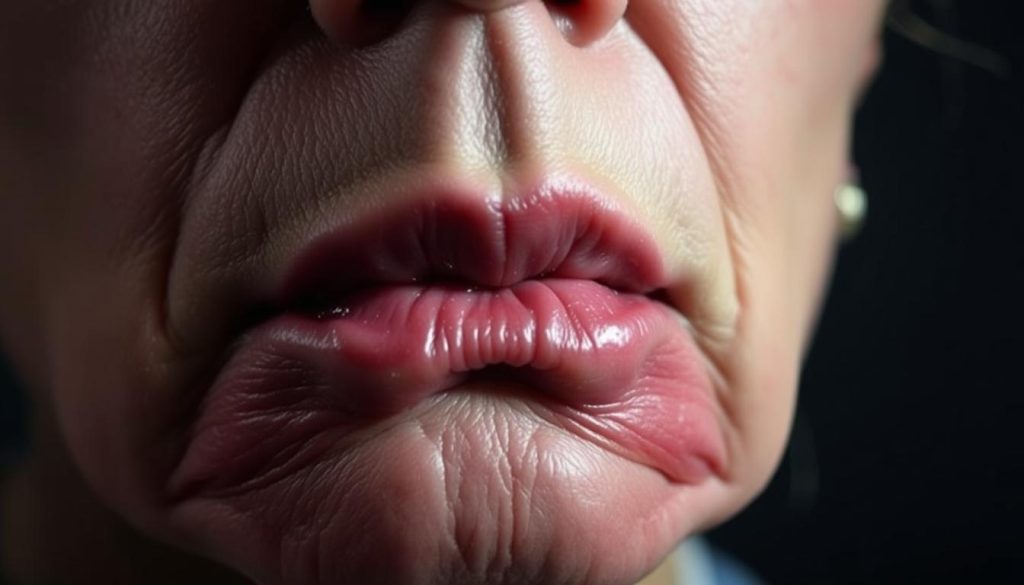
Serious Complications to Be Aware Of
More serious complications, though rare, can include infection at the surgical site, which may require antibiotic treatment or additional surgery. Asymmetry or contour irregularities are potential risks that may necessitate revision surgery if the final healed result shows significant unevenness.
When to Contact Your Surgeon
Patients should contact their plastic surgeon immediately if they experience excessive pain not controlled by medication, progressive swelling after the initial recovery period, signs of infection, exposure of any implant material, or significant asymmetry. Choosing a board-certified plastic surgeon specializing in facial reconstructive surgery significantly reduces the risk of complications and increases the likelihood of satisfactory results.
Expected Results and Patient Satisfaction
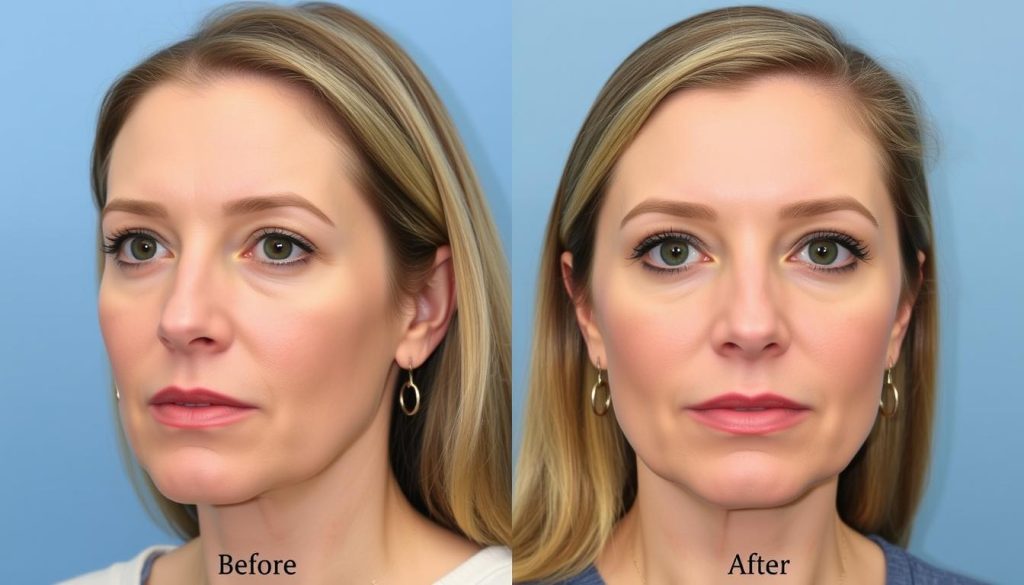
The results of chin reduction surgery can be life-changing, offering a more balanced facial profile. Chin reduction surgery delivers permanent results that continue to improve as swelling subsides, with final outcomes becoming fully apparent approximately 6-12 months after the procedure.
Patients typically report high satisfaction rates with chin reduction, noting improved facial harmony and better balance between their chin and other facial features, particularly the nose and forehead. The results create subtle yet significant improvements to the overall facial profile, often making patients look more refined without obviously appearing “surgically enhanced.”
- Chin reduction makes the face appear more oval or heart-shaped, creating a softer, more balanced appearance.
- Before-and-after comparisons show that successful chin reduction can make other features like the nose appear more proportionate.
- Long-term results remain stable over time, though natural aging processes will continue to affect the face and surrounding tissues.
To achieve the best possible results, patients should schedule consultation appointments with experienced surgeons who specialize in facial contouring and chin augmentation procedures. Realistic expectations are crucial for satisfaction, as chin reduction creates improvement rather than perfection.
FAQ
What is the typical recovery time for chin reduction?
The recovery time varies, but most patients can return to their normal activities within 1-2 weeks. Swelling and bruising may take several weeks to fully resolve.
Will there be visible scarring after the procedure?
The incision is typically made inside the mouth or under the chin, resulting in minimal visible scarring. The surgeon will discuss the best approach for each individual.
Can chin reduction be combined with other facial procedures?
Yes, chin reduction can be combined with other procedures such as rhinoplasty or facelifts to achieve a more balanced facial appearance. A consultation with a qualified plastic surgeon is necessary to determine the best approach.
What are the potential risks and complications associated with chin implant procedures?
As with any surgical procedure, there are risks and complications associated with chin implants, including infection, nerve damage, and implant displacement. A qualified surgeon will discuss these risks and how to minimize them.
How long do chin implants last?
Chin implants are designed to be long-lasting, but they may need to be replaced or adjusted over time. The lifespan of the implant depends on various factors, including the type of material used and the individual’s overall health.
What is the difference between sliding genioplasty and chin implant procedures?
Sliding genioplasty involves repositioning the bone to achieve a more balanced facial appearance, while chin implant procedures involve inserting a prosthetic device to enhance the chin. The choice between the two procedures depends on the individual’s specific needs and goals.
How is pain managed after chin reduction?
Pain is typically managed with medication prescribed by the surgeon. Patients are also advised to follow a soft-food diet and avoid strenuous activities to minimize discomfort.
